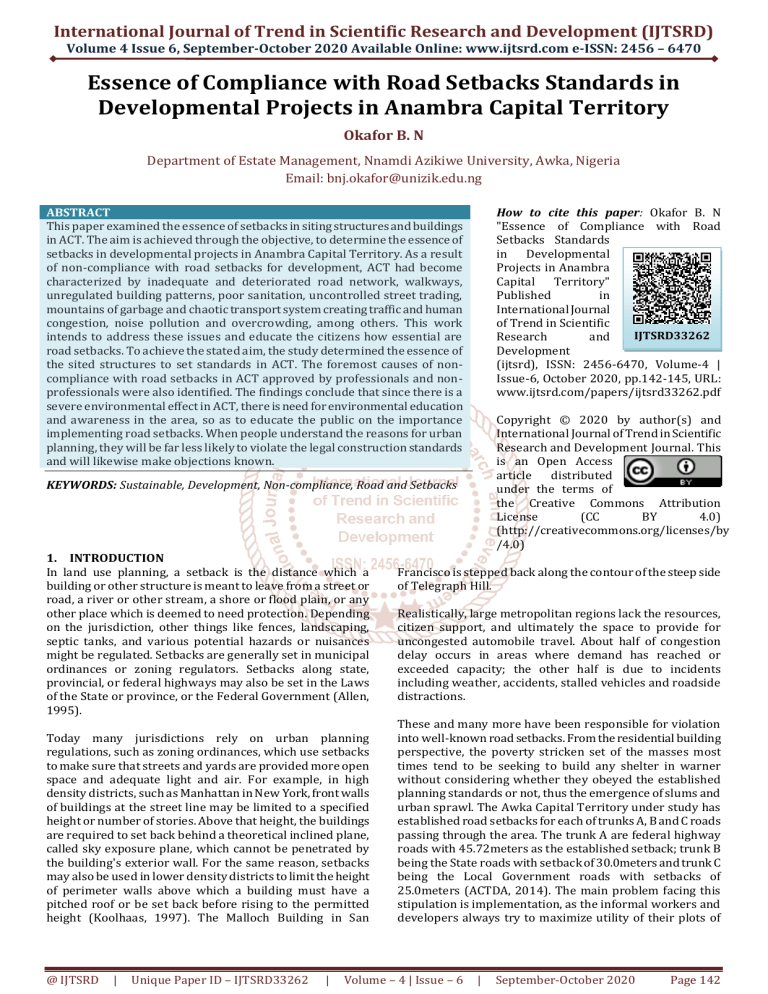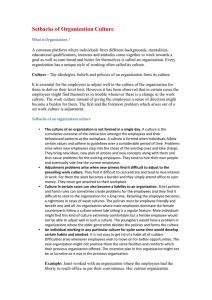
International Journal of Trend in Scientific Research and Development (IJTSRD)
Volume 4 Issue 6, September-October 2020 Available Online: www.ijtsrd.com e-ISSN: 2456 – 6470
Essence of Compliance with Road Setbacks Standards in
Developmental Projects in Anambra Capital Territory
Okafor B. N
Department of Estate Management, Nnamdi Azikiwe University, Awka, Nigeria
Email: bnj.okafor@unizik.edu.ng
ABSTRACT
This paper examined the essence of setbacks in siting structures and buildings
in ACT. The aim is achieved through the objective, to determine the essence of
setbacks in developmental projects in Anambra Capital Territory. As a result
of non-compliance with road setbacks for development, ACT had become
characterized by inadequate and deteriorated road network, walkways,
unregulated building patterns, poor sanitation, uncontrolled street trading,
mountains of garbage and chaotic transport system creating traffic and human
congestion, noise pollution and overcrowding, among others. This work
intends to address these issues and educate the citizens how essential are
road setbacks. To achieve the stated aim, the study determined the essence of
the sited structures to set standards in ACT. The foremost causes of noncompliance with road setbacks in ACT approved by professionals and nonprofessionals were also identified. The findings conclude that since there is a
severe environmental effect in ACT, there is need for environmental education
and awareness in the area, so as to educate the public on the importance
implementing road setbacks. When people understand the reasons for urban
planning, they will be far less likely to violate the legal construction standards
and will likewise make objections known.
How to cite this paper: Okafor B. N
"Essence of Compliance with Road
Setbacks Standards
in Developmental
Projects in Anambra
Capital Territory"
Published
in
International Journal
of Trend in Scientific
IJTSRD33262
Research
and
Development
(ijtsrd), ISSN: 2456-6470, Volume-4 |
Issue-6, October 2020, pp.142-145, URL:
www.ijtsrd.com/papers/ijtsrd33262.pdf
Copyright © 2020 by author(s) and
International Journal of Trend in Scientific
Research and Development Journal. This
is an Open Access
article
distributed
under the terms of
the Creative Commons Attribution
License
(CC
BY
4.0)
(http://creativecommons.org/licenses/by
/4.0)
KEYWORDS: Sustainable, Development, Non-compliance, Road and Setbacks
1. INTRODUCTION
In land use planning, a setback is the distance which a
building or other structure is meant to leave from a street or
road, a river or other stream, a shore or flood plain, or any
other place which is deemed to need protection. Depending
on the jurisdiction, other things like fences, landscaping,
septic tanks, and various potential hazards or nuisances
might be regulated. Setbacks are generally set in municipal
ordinances or zoning regulators. Setbacks along state,
provincial, or federal highways may also be set in the Laws
of the State or province, or the Federal Government (Allen,
1995).
Today many jurisdictions rely on urban planning
regulations, such as zoning ordinances, which use setbacks
to make sure that streets and yards are provided more open
space and adequate light and air. For example, in high
density districts, such as Manhattan in New York, front walls
of buildings at the street line may be limited to a specified
height or number of stories. Above that height, the buildings
are required to set back behind a theoretical inclined plane,
called sky exposure plane, which cannot be penetrated by
the building's exterior wall. For the same reason, setbacks
may also be used in lower density districts to limit the height
of perimeter walls above which a building must have a
pitched roof or be set back before rising to the permitted
height (Koolhaas, 1997). The Malloch Building in San
@ IJTSRD
|
Unique Paper ID – IJTSRD33262
|
Francisco is stepped back along the contour of the steep side
of Telegraph Hill.
Realistically, large metropolitan regions lack the resources,
citizen support, and ultimately the space to provide for
uncongested automobile travel. About half of congestion
delay occurs in areas where demand has reached or
exceeded capacity; the other half is due to incidents
including weather, accidents, stalled vehicles and roadside
distractions.
These and many more have been responsible for violation
into well-known road setbacks. From the residential building
perspective, the poverty stricken set of the masses most
times tend to be seeking to build any shelter in warner
without considering whether they obeyed the established
planning standards or not, thus the emergence of slums and
urban sprawl. The Awka Capital Territory under study has
established road setbacks for each of trunks A, B and C roads
passing through the area. The trunk A are federal highway
roads with 45.72meters as the established setback; trunk B
being the State roads with setback of 30.0meters and trunk C
being the Local Government roads with setbacks of
25.0meters (ACTDA, 2014). The main problem facing this
stipulation is implementation, as the informal workers and
developers always try to maximize utility of their plots of
Volume – 4 | Issue – 6
|
September-October 2020
Page 142
International Journal of Trend in Scientific Research and Development (IJTSRD) @ www.ijtsrd.com eISSN: 2456-6470
land, thereby encroaching into the setbacks and when they
are being apprehended, they cut corners to have their way.
1.1. Statement of the Problem
According to the Nigeria Bureau of Statistics (2006) the
population of Anambra State grew astronomically from
12percent to 48percent within a space of 12years. Anambra,
thus, became one of the most rapidly growing States east of
the River Niger. This type of growth also came with its
attendant consequences; the most significant being noncompliance with road setbacks, in the siting of structures in
the State.
As a result, ACT had become characterized by inadequate
and deteriorated road network, walkways, unregulated
building patterns, poor sanitation, uncontrolled street
trading, mountains of garbage and chaotic transport system
creating traffic and human congestion, noise pollution and
overcrowding, among others. It is because of these problems
that the study develop a workable template and modified
framework for solving the problems of non-compliance with
road setbacks as well as achieving sustainable urban
environmental socio-economic development in Awka Capital
Territory of Anambra State.
1.2. Objectives
The aim is achieved through the following objective
A. To determine the essence of setbacks in developmental
projects in Anambra Capital Territory
1.3. Research Hypotheses
The following hypotheses were postulated to guide this
study:
H0 : There is a significant essence of setbacks in
developmental projects in Anambra Capital Territory
1.4. Research Method
The study was conducted by mainly through the survey
method and interview of Professionals and nonprofessionals in ACT, Awka in Nigeria. Secondary data were
obtained through books, journals, and internet. Empirical
works of other scholars were consulted. A simple size of 400
was obtained from the population of 778,061 at 5% error
tolerance and 95% degree of freedom using Yamane’s
statistical formula 385(96.3%) of the questionnaires
distributed were returned while 15(3.7%) of the
questionnaires distributed were not returned. The
questionnaire was designed in Likert scale format. The
researchers conducted a pre-test on the questionnaire to
ensure the validity of the instrument. Data were collected
using relevant techniques (survey design, field
measurements, ARC GIS 10.4 software, and Maps). Simple
linear regression test was used to test this hypothesis, the
measured structures in ACT were compared to set standards
to know if they complied with standard or not.
2. Literature review
2.1. Essence of Setbacks in Developmental Projects
Spear (2006) studied bluff erosion of Lake Superior at
Madison-Wisconsin using both experimental and field
survey methods. Considering the reasons for setback
requirements, he stated that Lake Superior bluff shorelines
have been eroding for thousands of years and will continue
to do so. Because the erosion is often episodic, land owners
may not observe bluff recession over periods of a few years.
There may be periods of ten or more years with little or no
@ IJTSRD
|
Unique Paper ID – IJTSRD33262
|
erosion followed by several years of rapid erosion. To
protect a structure from this erosion and resulting bluff
retreat, it is necessary to have sufficient building setbacks to
account for this continuing process. This will minimize the
future chances of a building having to be moved or even
destroyed because of an unsafe location at the top of the
bluff.
Akhuewu (2010) assessed the impacts of on-street parking
on commercial activities in Auchi and identified the
characteristic of on-street parking which are noted to be the
nature of parking which affects the street based on the
nature of the environment. He observes that in developed
countries like Europe and America, majority of the vehicle
owners in a commercial area parked their cars in accordance
with the parking principles and guideline. This is because
there are provisions of parking space that are enough for
both the users of the spaces and those residing within the
area. This was as a result of planning with the inclusion of
parking facilities to discourage any obstruction on the
streets. The various characteristics that are linked with
street parking are advantageous due to monitoring and
control of street parking in the developed nations of the
world. In the African context, the nature of street parking is
different from the way it is in developed nations as noncompliance with the parking lots provisions abounds. In
some areas within the continent, roads are being constructed
without provision of or adherence to any setback, walkways,
and other necessary components of the road.
In the work of Rye (2010) on Parking Management for policy
makers in developing cities, he noted that the construction of
new roads, the expansion of existing roads, the building of
parking lot require the acquisition of part of the exchange
space. The more space allocated to transport, the greater the
requirement for more traffic space. According to him
automobile has an insatiable appetite for space, it uses space
at home, at work, shopping and even when some spaces are
empty, they are tied up or reserved for the automobile.
Automobiles do not only have exclusive space for moving,
they also have a” zone of influence” which expands as the
speed and quantity of traffic increases, thus reducing the
effectiveness of exchange space and the level of interaction.
Gruan(1972) studied cost of getting to work in New York
City noted that private Meanwhile, on-street parking in most
cases results into chaotic traffic due to parked cars along the
road and this has led to large amount of traffic circulating
looking for a parking space, thus contributing to congestion
and pollution.
Aluko (2011) assessed the level of public compliance to
space standards for urban development in Lagos State using
field survey (questionnaire survey and interview methods).
He found that from evidence on ground many parts of the
state is besieged with the issue of none observance of set
environmental development policies and laws, some of the
common contraventions identified include: Encroachment
on public rights of way and open spaces, Buildings spring up
under high-tension lines with their roofs a few metres below
the lines, General violation of urban and regional planning
laws in most states of the federation and construction of
properties on public utility setback. He stated that this
occurrence has caused the purpose of establishing these
laws and policies which is sustainable development to be
partially defeated or relegated to the background.
Volume – 4 | Issue – 6
|
September-October 2020
Page 143
International Journal of Trend in Scientific Research and Development (IJTSRD) @ www.ijtsrd.com eISSN: 2456-6470
Asiyanbola and Akinpelu, (2012), studied the challenges of
on-street parking in Nigerian cities’ transportation routes
using questionnaire survey method. They observed
categories of space in urban centres to include exchange
space and movement space, which related to motor park,
interchange point, etc. As city transportation system
expands, it takes up more spaces. They also noted that one of
the major goals of transportation planning, especially in the
provision of adequate road infrastructures, walkways,
setbacks, etc; is to ease the movement of passengers and
goods on urban roads. There is therefore need for extensive
walkways and setbacks in the design of any road network as
there may be need for expansion with time.
Olorunfemi (2013) assessed on-street parking in Lokoja
Nigeria, using questionnaire survey and field observation
methods. In his findings he stated that in most of the cities in
developing countries the planning of road networks lacks the
provision of the entire basic infrastructure to be provided for
the safe and orderly movement of vehicles. An ideal road
network should have exclusive lanes to segregate fast
moving and slow moving vehicles, cycle lanes, exclusive bus
bay, service lanes and extensive walkways and setbacks.
When all these are not strictly adhered to, there is bound to
be problems with time like road failure, traffic congestion,
accidents and subsequent loss of lives and property through
demolition processes in the bid to expand the existing roads.
3. Results and Discussion
3.1. Test of Hypothesis
There is a significant essence of setbacks in developmental projects in Anambra Capital Territory. The hypothesis postulated
was tested with test statistics aided by computer applied Statistical Package for Social Sciences (SPSS: 20.00s version) of
Microsoft environment. Simple linear regression test was used to test this hypothesis, the measured structures in ACT were
compared to set standards to know if they complied with standard or not.
Table 3.1 Descriptive Statistics
Mean Std. Deviation
Essence of setbacks
1.7766
.51738
Developmental project 3.4727
.85386
Pearson Correlation
Sig. (1-tailed)
N
Table 3.2 Correlations
Essence of setbacks
Essence of setbacks
1.000
Developmental Project
.682
Essence of setbacks
.
Developmental Project
.000
Essence of setbacks
385
Developmental Project
385
N
385
385
developmental projects
.682
1.000
.000
.
385
385
Table 3.3 Model Summaryb
Model
R
R Square Adjusted R Square Std. Error of the Estimate
1
.682a
.465
.463
.37899
a. Predictors: (Constant), Essence of setbacks
b. Dependent Variable: Developmental Project
Table 3.4 ANOVAb
Model
Sum of Squares Df Mean Square
Regression
47.778
1
47.778
1
Residual
55.012
302
.144
Total
102.790
303
a. Predictors: (Constant), Essence of setbacks
b. Dependent Variable: Developmental Project
Model
(Constant)
Essence of setbacks
1
R
R2
F
DW
F
332.632
Durbin-Watson
.064
Sig.
.000a
Table 3.5 Coefficientsa
Unstandardized Coefficients Standardized Coefficients
B
Std. Error
Beta
.342
.081
.413
.023
.682
T
Sig.
14.223
18.238
.000
.000
= 0.682
= 0.465
= 332.632
= .064
Interpretation:
The regression sum of squares (47.778) is less than the
residual sum of squares (55.012), which indicates that more
of the variation in the dependent variable is not explained by
@ IJTSRD
|
Unique Paper ID – IJTSRD33262
|
the model. The significance value of the F statistics (0.000) is
less than 0.05, which means that the variation explained by
the model is not due to chance.
Volume – 4 | Issue – 6
|
September-October 2020
Page 144
International Journal of Trend in Scientific Research and Development (IJTSRD) @ www.ijtsrd.com eISSN: 2456-6470
R, the correlation coefficient which has a value of 0.682,
indicates that there is a positive relationship between the
Essence of setbacksand developmental projects. R square,
the coefficient of determination, shows that 46.5% of the
variation is explained by the model.
With the linear regression model, the error of estimate is
high, with a value of about 0.37899. The Durbin Watson
statistics of .064, which is not tends to 2 indicates there no is
autocorrelation.
The organizational enabler coefficient of 0.682 indicates a
positive significance between Essence of setbacksand
developmental projects, which is statistically significant
(with t = 14.223). Therefore, the null hypothesis should be
rejected and the alternative hypothesis accordingly accepted.
3.2. Discussions of Result
From the findings the hypothesis was tested with simple
linear regression to determine the essence of setbacks in
developmental projects in Anambra Capital Territory. With a
computed result (r = 0.682; F= 332.632; t= 14.223; p <
0.05).The alternate hypothesis was accepted resulting in the
conclusion that there is a significant essence of setbacks in
developmental projects in Anambra Capital Territory.
4. Conclusion and Recommendations
4.1. Conclusion
Based on the findings, the following conclusions were
drawn: there is massive incidence of non-compliance with
road setbacks in ACT and the major causes of it are the
corruption of planning authority and failure of law
enforcement agents. Due to the low level of compliance to
the ACTDA standard, it is also concluded that there is high
rate of non-compliance with road setbacks in siting of
structures in ACT.
The Built environment in Nigerian cities was on the available
spaces on land not in the air, if those illegal structures are
built in discriminately on available spaces by the landowners
and developers. Where were planning authorities and law
enforcement agents then? Were they not the same people
that allowed them abolition to encroach into the road
setbacks and were they not the same that demolish those
illegal structures in the same urban areas? It is therefore
noteworthy that the corruptions among planning authorities
and failure of law enforcement agents are the brain behind
the causes and environmental implications respectively on
non-compliance with roads setbacks in the siting of
structures in a given urban environment. Why cannot you
comply fully with road setback regulations and enjoy with
your future generations hence sustainable development.
4.2. Recommendations
From the findings made, the following recommendations
were made:
Provided that there is massive incidence of non-compliance
with road setbacks in ACT, to adequately handle the problem
of non-compliance with road setbacks in the area, there is
need for post occupancy assessment which deals with the
continuous periodic/systematic assessment of the level of
compliance to road setbacks and environmental orderliness
of sited structures in terms of aesthetics, drainage,
accessibility, productivity and sustainability. This can
effectively be done by Estate Managers/Surveyors for
@ IJTSRD
|
Unique Paper ID – IJTSRD33262
|
sustainable urban environment and socio-economic
development. Without proper management and
maintenance, there would be nothing like sustainable
development.
Since there is a severe environmental effect in ACT, there is
need for environmental education and awareness in the
area, so as to educate the public on the importance of
implementing road setbacks. When people understand the
reasons for urban planning, they will be far less likely to
violate the legal construction standards and will likewise
make objections known, when their neighbors, relatives,
friends, even their enemies build illegally. For the
environment to gain its quality and aesthetic beauty, all
hands should be on deck.
Finally, since Government has not obtained the power of
eminent domain to acquire community lands due to inability
to compensate the community land owners who normally
sell their community lands to the people who violate the
road setbacks in a bid to maximize their lands. Government
should therefore buy up the lands at the on-going rent, resell
them to the people and resort to judicial process to enforce
compliance. This can help immensely to rehabilitate the old
traditional urban development and move to new modern
urban development in ACT.
References
[1] Ademola, Adeyemi (2001). Paper on Strategies for
Sustainable Land use Planning and Management in
Nigeria..Paper presented at the 21st Century at Joint
Workshop/meeting of Lands officers and ZTPOS held
in Abuja 5th & 6th December, 2001.
[2] Adindu, I. F. (2005). Physical Planning in History
published by Jube Evans Books and Publications, Bida,
Nigeria, printed by Blessed Concept Prints.
Administration in Nigeria. Ibadan: Kraft Books Limited
[3] Awka Capital Territory Development Authority
(ACTDA) (2014). Development Control Manual for
Awka Capital Territory. 40-41.
[4] Okafor, B.N (2018). Compliance with Road Setbacks
Standards in Siting of Structures in Awka Capital
Territory:
Implications
for
Environmental
Management. Unpublished Postgraduate PhD Research
in Environmental Management: Submitted to the
Department of Environmental Management, Faculty of
Environment Sciences, NAU Awka Nigeria.
[5] Okoro H. I. (2009). Housing Delivery in Nigeria: Policies
and Challenges. Proceedings ofThe World Urban Forum
5, Rio de Janeiro, Brazil March 2010, Published by
Wonders Print Abaji.
[6] Okoro H. I. (2013). The Effect of Long Distance Journey
from Home to School on the Output of Teachers in
Gwarinpa District Primary Schools, Abuja.Unpublished,
Postgraduate Diploma Research in Education; submitted
to Nigerian Teachers’ Institute, Kaduna.
[7] Olomola, A. S. (2003). Understanding poverty in Nigeria:
highlights from NISER review of Nigerian development
in NISEREEL, the Magazine of the Nigerian Institute of
Social and Economic Research, 4 & 5, Ibadan.
[8] Onibokun, A. O. (2007). National Physical Development
Plan as an instrument for Urban & Regional
Development. Proceedings of the Conference of
Directors & Heads of Planning Organizations in Nigeria.
at Asaba, 2nd November, 2007.
Volume – 4 | Issue – 6
|
September-October 2020
Page 145



